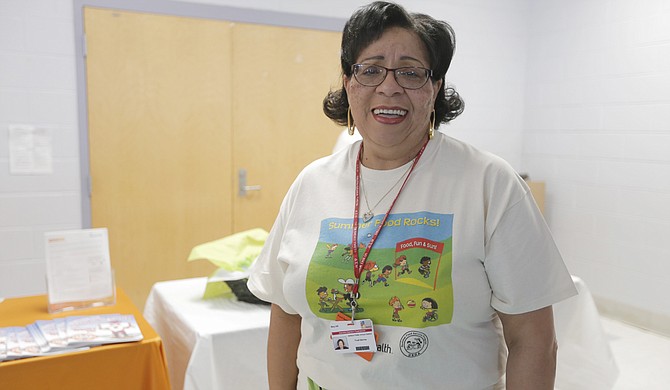Mary Hill, executive director of the Department of Food Service for Jackson Public Schools, says they will continue to provide meals for children until next month. Photo by Imani Khayyam.
JACKSON — Hundreds of Jackson-area children gathered at McWillie Elementary School today to for the opportunity to eat lunch, learn healthy habits and, time permitting, hit the Quan.
Representatives from Jackson Public Schools, the Mississippi Department of Education's Office of Healthy Schools and the U.S. Department of Housing and Urban Development, along with corporate sponsor Magnolia Health, gathered at McWillie Elementary for a "spike event" for the U.S. Department of Agriculture's Summer Food Service Program. Mary Hill, executive director of the Department of Food Service at JPS, says the event's purpose is to inform the community that the feeding program, which kicked off on June 6 of this year, will last until July 15.
The program provides meals for low-income children 18 and younger when school is out. The purpose of the program is to help combat hunger and food insecurity for kids who might not have the same access to regular meals at home during the summer that they have during the school day. This summer, the program will provide more than 40,939 meals to the children who participate.
"It's important for them to get healthy meals throughout the summer, as well as during school," said Mary Anna McDonnieal, director of marketing for Magnolia Health. She says the program, happening statewide, has far-reaching benefits for Mississippians who might struggle to feed their families due to a scarcity of healthy food options.
Around the state, food insecurity and high poverty necessitate the program. In its 2015 report TalkPoverty.org, an affiliate of the Center for American Progress, ranks the state of Mississippi 51st in the nation in hunger and food insecurity, down from 50th last year. The USDA reported in 2014 that from 2012 to 2014, 22 percent of Mississippi households said they didn't have the resources to provide enough food for their families—8 percentage points above the national average of 14 as reported by the USDA.
The Mississippi Food Insecurity Project reports that research predicts grim outcomes for the food insecure, including higher health-care costs and a greater likelihood of diabetes, high blood pressure and other illnesses. MFIP says households with children with at a rate of 19.2 percent and households headed by black and non-black Hispanic people, with rates at 26 and 22.4 percent, respectively, have high rates of food insecurity.
Though JPS reports that 78 percent of its students qualify for free or reduced meals, the district offered free breakfast and lunch throughout the district for the 2015-2016 school year as part of the Community Eligibility Program. Hill says the program is exciting for parents.
"Parents think it's wonderful that they know their children will be getting a nutritious meal throughout the day," she said.
The program will offer meals at not only schools, but also HUD and low-income housing complexes and recreation centers and religious institutions. Not only JPS students are eligible for the program; the free lunch program is open to the public.
"The most important piece (of this event) is to continue food service," Hill said. "We don't just stop when school's out."
You can read the menu and find service sites here.
Sierra Mannie is an education reporting fellow for the Jackson Free Press and The Hechinger Report. Read more at jfp.ms/education.
More like this story
More stories by this author
- Minding the Equity Gap: How Majority-Black Clinton District Earns Its ‘A’ Rating
- Beyond Blame: JPS Works to Avoid State Takeover of Local Schools
- Facing Takeover, JPS Corrective Action Gains Urgency
- Licensing Mississippi’s Teachers: A Shift in Control?
- Takeover of JPS Looms as District Addresses Probation, Audit



Comments
Use the comment form below to begin a discussion about this content.